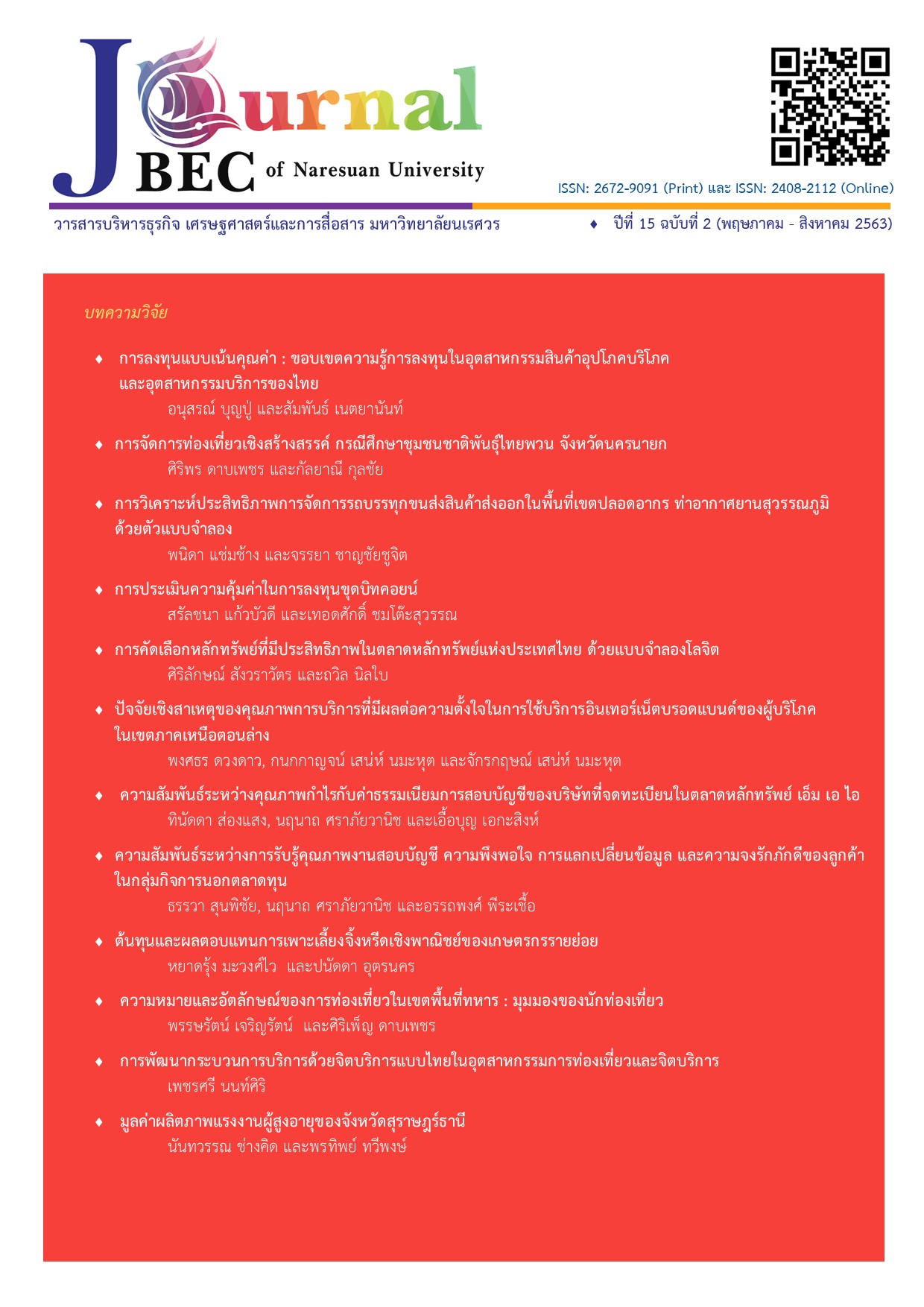การคัดเลือกหลักทรัพย์ที่มีประสิทธิภาพในตลาดหลักทรัพย์แห่งประเทศไทย ด้วยแบบจำลองโลจิต
Main Article Content
บทคัดย่อ
บทความนี้มีวัตถุประสงค์เพื่อศึกษาคุณลักษณะของหุ้นที่ส่งผลต่อความมีประสิทธิภาพของหุ้นที่จดทะเบียน
ในตลาดหลักทรัพย์แห่งประเทศไทย การศึกษาได้สร้างตัวแบบ Binary Logistic เพื่อพยากรณ์ความน่าจะเป็นของหุ้นที่มีอัตราผลตอบแทนที่สูงกว่าอัตราผลตอบแทนของตลาดหลักทรัพย์ ซึ่งเรียกว่า “หุ้นที่มีประสิทธิภาพ” และความน่าจะเป็นที่หุ้นจะมีอัตราผลตอบแทนต่ำกว่าตลาด ซึ่งเรียกว่า “หุ้นที่ไม่มีประสิทธิภาพ” การศึกษาใช้ข้อมูลของหุ้นที่อยู่ใน SET 100 ในช่วงปี พ.ศ. 2557-2561 โดยแบ่งการวิเคราะห์เป็น 2 กรณี คือ ผลตอบแทนของหุ้นพิจารณาเฉพาะส่วนเพิ่มของราคาหุ้น (Capital gain) และผลตอบแทนของหุ้นรวมส่วนเพิ่มของราคาหุ้นและเงินปันผล (Capital gain and dividend)
ผลการศึกษาพบว่า ทั้ง 2 กรณีให้ข้อสรุปเหมือนกัน กล่าวคือ มี 3 ปัจจัย ได้แก่ อัตราส่วนราคาต่อมูลค่าทางบัญชี กำไรสุทธิต่อหุ้น และอัตรากำไรขั้นต้น ที่มีนัยสำคัญต่อการกำหนดความน่าจะเป็นที่หุ้นจะเป็นหุ้นที่มีประสิทธิภาพหรือไม่มีประสิทธิภาพ และทั้ง 3 ปัจจัยนี้ส่งผลในทิศทางบวก ขณะที่อีก 3 ปัจจัยไม่มีนัยสำคัญในการกำหนด ได้แก่ ความเสี่ยง
ของหุ้น อัตราส่วนราคาตลาดต่อกำไรสุทธิ และอัตราผลตอบแทนต่อส่วนของผู้ถือหุ้น
คำสำคัญ: 1) การคัดเลือกหลักทรัพย์ 2) หุ้นมีประสิทธิภาพ 3) หุ้นไม่มีประสิทธิภาพ 4) แบบจำลองโลจิต
Article Details
เอกสารอ้างอิง
Ali, S. S., Mubeen, M., Lal, I. and Hussain, A. (2018). Prediction of stock performance by using logistic regression model: evidence from Pakistan Stock Exchange (PSX). Asian Journal of Empirical Research, 8(7), 247-258
Bodie, Z., Kane, A., and Marcus, A. J. (2014). Investments (10th Ed.). New York: McGraw-Hill Education.
Boonthueng, K. (2012). Factors influencing on stock price of the listed company in the SET : A case study of property and construction industries. Master thesis, M.Acc., Kasetsart University, Bangkok.
Dutta, A., Bandyopadhyay, G. and Sengupta, S. (2012). Prediction of stock performance in the India stock market using logistic regression. International Journal of Business and Information, 7(1), 105-136.
Kuakoon, R. (2014). Measuring the efficiency of securities registered on the stock exchange of Thailand in the SET 100 index group using Data Envelopment Analysis. Master thesis, M.Econ.,Ramkhamhaeng University, Bangkok.
Nailbai, T. (2016). Applied Econometrics. Bangkok: Ramkhamhaeng University Press.
Sangkaew, J. (2004). Invesment. Bangkok: Thammasat University Press.
Thailand Securities Institute Professional Education. (2009). Money market and securities investment (8th ed.). Bangkok: Amarin Printing & Publishing.
The Stock Exchange of Thailand. (2017). Market Statistics, Retrieved November 16, 2017, from https://www.set.or.th/th/market/market_statistics.html
Qaisi, F. A., Tahtamouni, A. and Qugah, M. (2016). Factors affecting the market stock price – The case of the insurance companies listed in Amman Stock Exchange. International Journal of Business and Social science, 10(7), 81-90.
Upadhyay, A., Dutta, A. and Bandyopadhyay, G. (2012). Forecasting stock performance in Indian market using multinomial logistic regression. Journal of Business studies Quarterly, 3(3), 16-39.
Upatcha, E. (2013). Factors affecting selective stock price in market for alternative investment (mai). Master thesis, M.B.E., Kasetsart University, Bangkok.
Utami, W. R., Hartoyo, S. and Maulana, T. A. (2015). The effect of internal and external factors on stock return: Empirical evidence from the Indonesian construction subsector. Asian Journal of Business and Management, 5(3), 370-377.


